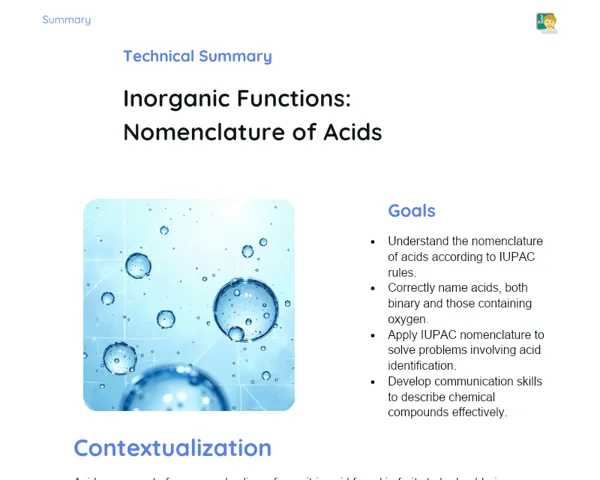Summary Tradisional | Organic Functions: Ester Nomenclature
Contextualization
Esters are organic compounds that originate from carboxylic acids, where the hydrogen in the carboxyl group is replaced by an alkyl or aryl group. These compounds are commonly used in everyday products like fragrances, artificial flavors, and even medications. The study of esters is fundamental for understanding their structure and properties, as well as their practical applications that touch our daily lives.
Learning the nomenclature of esters as per IUPAC guidelines is essential for identifying and distinguishing these compounds from others. By mastering the rules of nomenclature, students will enhance their ability to recognise and accurately name esters, which will aid scientific communication and the practical application of their knowledge. Moreover, understanding ester nomenclature is vital for those aiming for careers in science and engineering, fields where a detailed knowledge of organic compounds is frequently needed.
To Remember!
Definition of Esters
Esters are organic compounds that stem from carboxylic acids, where the hydrogen of the carboxyl group (COOH) is substituted by an alkyl (R) or aryl (Ar) group. The general structure of esters can be denoted by the formula R-COO-R', where R and R' represent hydrocarbon chains that vary in length and complexity.
Esters are frequently encountered in a range of common products like perfumes, artificial flavours, and even medicines. They are significant in organic chemistry due to their distinctive properties and versatility in chemical reactions. Comprehending the structure and nomenclature of esters is crucial for effectively identifying and differentiating these compounds from other functional groups.
Besides their practical uses, esters are also key intermediates in various chemical syntheses. They can be synthesised via esterification reactions, where a carboxylic acid reacts with an alcohol in the presence of an acid catalyst. This process is widely employed in industries for the bulk production of esters.
-
Esters are derived from carboxylic acids.
-
The general formula for esters is R-COO-R'.
-
They are present in perfumes, artificial flavours, and medications.
-
They serve as important intermediates in chemical syntheses.
IUPAC Nomenclature of Esters
The nomenclature of esters adheres to specific rules laid down by IUPAC (International Union of Pure and Applied Chemistry). To name an ester, one must first identify the alkyl group (R') attached to the oxygen, followed by the name of the corresponding carboxylic acid, modified to end with 'ate'. For instance, the ester formed from acetic acid and ethanol is referred to as ethyl acetate.
Proper nomenclature is vital for effective scientific communication, as it enables chemists to accurately identify and differentiate compounds. Furthermore, a systematic approach to naming helps prevent ambiguities and confusion, particularly with compounds featuring complex structures.
To reinforce comprehension, practicing with various examples of esters is beneficial, such as methyl formate (H-COO-CH3), propyl propanoate (CH3-CH2-COO-CH2-CH2-CH3), and methyl butanoate (CH3-CH2-CH2-COO-CH3). These examples exemplify the rules of nomenclature in action and aid students' learning.
-
Start by naming the alkyl group attached to the oxygen.
-
Subsequently, name the corresponding carboxylic acid with the ending 'ate'.
-
IUPAC nomenclature is key for effective scientific communication.
-
Practice with diverse examples to reinforce understanding.
Difference Between Esters and Other Organic Compounds
It's crucial to differentiate esters from other organic compounds, such as alcohols, carboxylic acids, and ethers. Esters have the general formula R-COO-R', featuring a carbonyl group (C=O) linked to an oxygen, which is also connected to an alkyl or aryl group. This structural arrangement distinguishes esters from other compounds.
In contrast, alcohols follow the formula R-OH, characterised by a hydroxyl group (OH) bonded to a carbon. Carboxylic acids are denoted by the formula R-COOH, which includes the carboxyl group (COOH). Ethers are represented by the formula R-O-R', where an oxygen atom is bonded to two alkyl or aryl groups, lacking the carbonyl group.
Grasping these distinctions is vital for accurately identifying compounds during chemical analyses and for employing particular reactions. Each functional group possesses unique properties and reactivities, impacting how compounds react under diverse chemical conditions.
-
Esters have the formula R-COO-R' and include a carbonyl group.
-
Alcohols are represented by the formula R-OH and possess a hydroxyl group.
-
Carboxylic acids use the formula R-COOH and have a carboxyl group.
-
Ethers follow the formula R-O-R' and do not contain a carbonyl group.
Applications of Esters
Esters find a vast array of practical applications across various industries. They are widely utilised in the fragrance and artificial flavour industries, owing to their pleasing aromas and taste profiles. For example, the scent of green apples and the flavour of pineapples can be attributed to different esters.
In the food sector, esters are employed to create artificial flavours in items like candies, gums, and drinks. They are also incorporated into the production of edible oils and fats, contributing to the overall texture and taste of the products.
Moreover, esters play a significant role in the pharmaceutical field. Many medications are formulated as esters to enhance their absorption and bioavailability. Additionally, esters serve as solvents and intermediates in chemical syntheses, marking them as critical components in numerous industrial processes.
-
Utilised in fragrances and artificial flavours.
-
Applied in the food industry to create synthetic flavours.
-
Significant in pharmaceuticals for better drug absorption.
-
Used as solvents and intermediates in chemical syntheses.
Key Terms
-
Esters: Organic compounds derived from carboxylic acids, where the hydrogen of the carboxyl group is replaced by an alkyl or aryl group.
-
IUPAC Nomenclature: A set of rules established by the International Union of Pure and Applied Chemistry for systemically naming chemical compounds.
-
Alkyl Group: A functional group derived from an alkane by removal of a hydrogen atom, represented by the general formula R-.
-
Carboxyl Group: A functional group present in carboxylic acids, made up of a carbon atom doubly bonded to an oxygen atom and bonded to a hydroxyl group (COOH).
-
Carboxylic Acid: An organic compound that contains the carboxyl functional group (COOH).
-
Fragrances: Substances that release pleasant aromas, often found in esters.
-
Artificial Flavours: Compounds that mimic natural flavours in food and drink, commonly sourced from esters.
Important Conclusions
In this lesson, we covered the definition and nomenclature of esters, underscoring their significance in organic chemistry and their numerous practical uses. We learned that esters are formed from carboxylic acids, where the hydrogen in the carboxyl group is replaced by either an alkyl or aryl group, and we explored how IUPAC nomenclature is utilised to systematically and accurately name them. This nomenclature is fundamental for scientific interactions and proper identification of these compounds within various practical contexts.
Furthermore, we delved into how to distinguish esters from other organic compounds like alcohols, carboxylic acids, and ethers, highlighting their unique structures and attributes. This differentiation is vital for the precise analysis and application of these compounds in chemical reactions. The practical applications of esters were also mentioned, stressing their roles in fragrances, artificial flavours, and medications, demonstrating the importance of these compounds in our everyday lives.
Lastly, we reaffirmed the importance of the knowledge acquired regarding ester nomenclature for those pursuing careers in science and engineering. This understanding not only aids grasping more advanced concepts in organic chemistry but also equips students to address academic and professional challenges, fostering a better comprehension and application of the properties and reactivities of organic compounds.
Study Tips
-
Review the examples of ester nomenclature discussed in class, practising naming new compounds to reinforce understanding.
-
Study the structural distinctions between esters and other organic compounds like alcohols, carboxylic acids, and ethers to ensure correct identification.
-
Investigate the practical applications of esters in various sectors, such as food, fragrances, and pharmaceuticals, to better appreciate their significance and utility.



